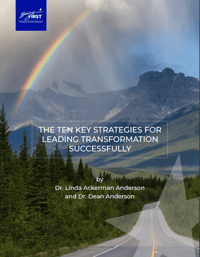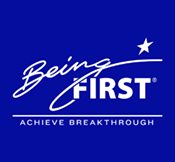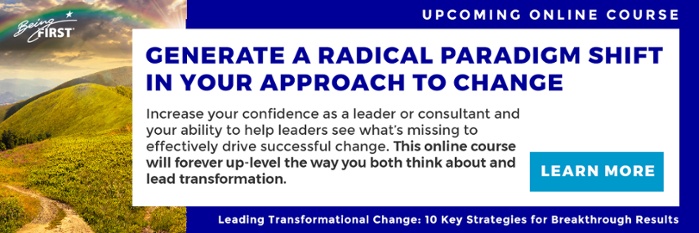Most organizational change and transformation originates from executives, but executives cannot make the change happen alone. Without the help of managers, employees and support staff, getting employees on board with your big change initiatives tends to be almost impossible. Executives must learn how to design change initiatives so that they engage the commitment of other leaders and the workforce. Here's how.
Relevance
Change has the greatest chance of success when it is “co-created,” and a typical “command and control” style of leadership is usually ineffective. When faced with resistance, many executives blame their staff and others for not getting on board with their change initiative ideas. In a command and control mindset, they then “push harder” and direct more, which often exacerbates the resistance. You can go so far as to say they are actually helping cause the resistance by not effectively communicating the relevance and meaning of the change. Most people resist change when they cannot see its value. How, then, should executives go about getting employees committed to their change initiatives?
Explain the Change Initiative in Terms of Its Relevance and Meaning
In order to believe in change, employees must feel like they personally relate to these change initiatives. Change often brings confusion and resistance, and the best way to combat this is by involving employees in the process and helping them understand the value the desired outcomes it will produce.
Explain to them:
Why is this change initiative necessary and beneficial?
Help your employees see how their efforts will reap rewards. Implementing this change will no doubt be hard work, and they want to know specifically what the payoff will be. Is the end result something that is meaningful to them? Otherwise, they’ll wonder, ”What’s the point?”
How will this change contribute to the success of the business?
All businesses have a set of strategies and goals, and your change initiative should align with these and help deliver them. Every employee wants to see the organization be successful - show them how this change helps the company achieve its goals.
How do you, personally, fit into this change initiative?
Will their job role stay the same? Will they still be reporting to their current supervisor, or will their team be adjusted or disbanded? If there is uncertainty regarding these issues, employees will have difficulty committing to the change.
People Change from the Inside Out
As with most major change, you cannot force someone to do something that they don’t want to do themselves. This is especially true for major organizational change, which will invariably consume much of your employees’ time, resources, and energy (on top of their normal day-to-day tasks).
When faced with an opportunity to change, employees often rationalize the change efforts in their head. Do they understand the leader’s rationale for the change? Do they believe the end result will be worth the effort? Do they believe the change will be long-lasting or short-lived?
The key is to help them see the value of the change so they become inherently motivated. Otherwise, your only recourse is the carrot or the stick, neither of which generates or sustains commitment. But when employees get excited about the outcomes a change initiative will produce, watch out. They’ll be pushing you to move faster!
People Need Time to Go Through Their Natural Emotional Transition
You cannot order employees to be positive about any given change effort. Only they can determine, from their own internal mindset, that they like or dislike the direction of a change. Often, people have an initial negative emotional reaction to change simply because it is initially unclear, and the unknown makes them uncomfortable. There is a natural emotional transition that people must go through during immense upheaval, and you cannot rush or fight this.
Think about it - employees have just been told about a major transformational change initiative. They may be upset about disturbing the status quo, scared for the future of their job, wonder if they’ve got the skills to succeed in the new world, or simply be confused by the announcement. Helping them work through this natural set of emotions so they can transition out of them, rather than trying to force acceptance, will get them on board much faster. But you have got to give them some time.
How to Get Stakeholders Engaged in Your Change Initiatives
In order to maximize results from your change initiative, help employees become invested in the change by involving them in every way you can. This helps them feel like they have some control over their futures and the direction of the company, and as a leader it could provide valuable feedback. According to this article from CIO on the 8 Secrets of Effective Change Leaders, "Executives who want employees to embrace change need to do more than seek buy-in; they have to share ownership of the project with the individuals impacted by it."
Employee engagement can take the form of brainstorming sessions, inputting to the vision, desired outcomes or design requirements, being part of a communication or culture team, doing benchmarking, identifying impacts of the change, generating sustainment strategies, designing training, or any form of two-way communications. Keep people involved by communicating often, and answering employee questions as they come.
For successful organizational change, employees must feel as though the change has personal meaning to them, and getting them engaged is the best way to generate that feeling. How will the change help them and their futures? What, exactly, will it take for them to be successful? What will this change look like, and where do they fit in? How can they participate actively in it? If you answer these questions and any others they may have, employees will be much more inclined to help your organization transform as needed to achieve your strategies and goals.
Related eBook:
The Ten Key Strategies for Leading Transformation

Through 40 years of observing and supporting large-scale change and transformation in Fortune 500, government, global NGOs and public service organizations, we’ve identified these ten Best Practice strategies for leading transformation successfully.
Please complete the form to download your eBook:
Related Webinar:
Stakeholder Engagement - How to Reduce Resistance
In this webinar, Dr. Linda Ackerman Anderson discusses key, early stakeholder engagement opportunities and reveals how change leaders can maximize these opportunities to save time, save money and increase commitment and meaningful participation.

